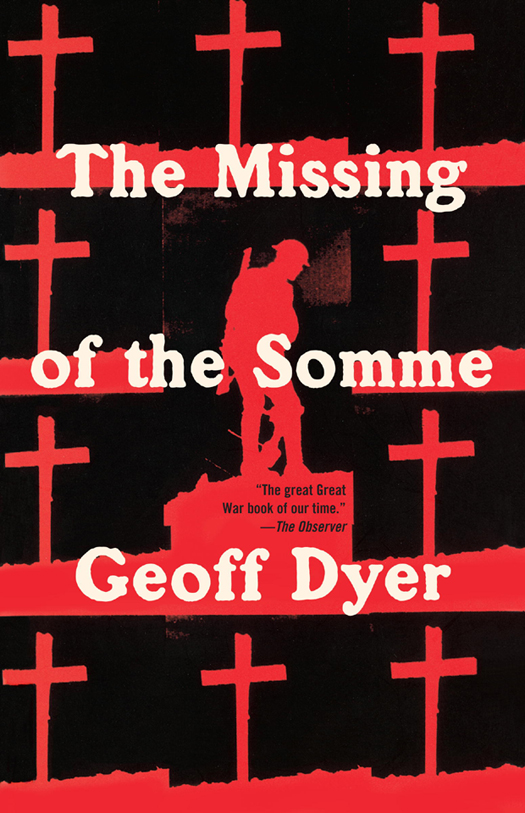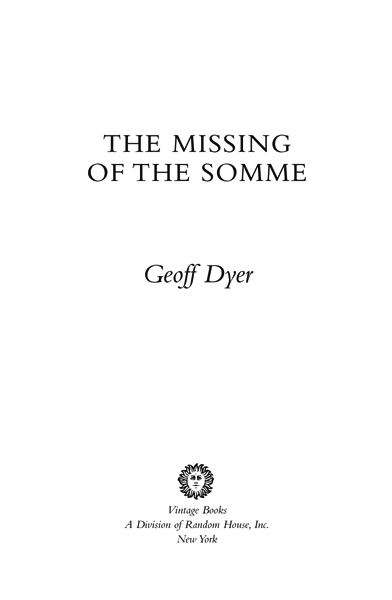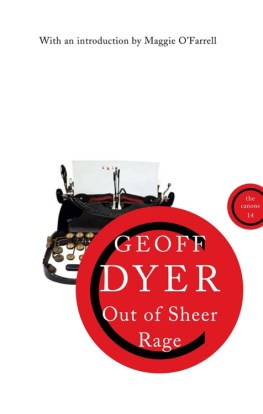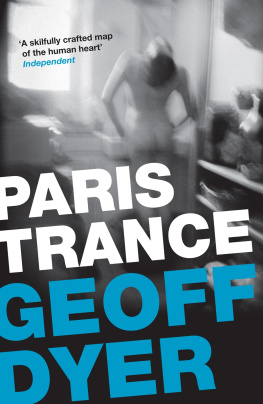Geoff Dyer - The Missing of the Somme
Here you can read online Geoff Dyer - The Missing of the Somme full text of the book (entire story) in english for free. Download pdf and epub, get meaning, cover and reviews about this ebook. year: 2011, publisher: Vintage, genre: Art. Description of the work, (preface) as well as reviews are available. Best literature library LitArk.com created for fans of good reading and offers a wide selection of genres:
Romance novel
Science fiction
Adventure
Detective
Science
History
Home and family
Prose
Art
Politics
Computer
Non-fiction
Religion
Business
Children
Humor
Choose a favorite category and find really read worthwhile books. Enjoy immersion in the world of imagination, feel the emotions of the characters or learn something new for yourself, make an fascinating discovery.

- Book:The Missing of the Somme
- Author:
- Publisher:Vintage
- Genre:
- Year:2011
- Rating:5 / 5
- Favourites:Add to favourites
- Your mark:
- 100
- 1
- 2
- 3
- 4
- 5
The Missing of the Somme: summary, description and annotation
We offer to read an annotation, description, summary or preface (depends on what the author of the book "The Missing of the Somme" wrote himself). If you haven't found the necessary information about the book — write in the comments, we will try to find it.
The Missing of the Somme — read online for free the complete book (whole text) full work
Below is the text of the book, divided by pages. System saving the place of the last page read, allows you to conveniently read the book "The Missing of the Somme" online for free, without having to search again every time where you left off. Put a bookmark, and you can go to the page where you finished reading at any time.
Font size:
Interval:
Bookmark:


Geoff Dyer
THE MISSING OF THE SOMME
Geoff Dyer is the author of four novels, a critical study of John Berger, and five other books, including But Beautiful, which was awarded the Somerset Maugham Prize, and Out of Sheer Rage, which was a National Book Critics Circle finalist. He lives in London.
www.geoffdyer.com
ALSO BY GEOFF DYER
Otherwise Known as the Human Condition: Selected Essays and Reviews
Jeff in Venice, Death in Varanasi
The Ongoing Moment
Yoga for People Who Cant Be Bothered to Do It
Paris Trance
Out of Sheer Rage
The Search
But Beautiful
The Colour of Memory
Ways of Telling: The Work of John Berger

A VINTAGE BOOKS ORIGINAL, AUGUST 2011
Copyright 1994 by Geoff Dyer
All rights reserved. Published in the United States by Vintage Books, a division of Random House, Inc., New York. Originally published in hardcover in Great Britain by Hamish Hamilton, London, in 1994, and subsequently published in paperback by Phoenix, an imprint of Orion Books Ltd, London, in 2009.
Vintage and colophon are registered trademarks of Random House, Inc.
Cataloging-in-Publication Data is on file at the Library of Congress.
eISBN: 978-0-307-74323-7
Author photograph Matt Stuart
www.vintagebooks.com
Cover design: Carson Dyle
v3.1
For my mother and father
Remember: the past wont fit
into memory without something left over;
it must have a future.
Joseph Brodsky
A kaleidoscope of hypothetical contingencies
T. H. Thomas, reviewing Basil Liddell Harts
The Real War in 1931
The anticipation of memory
Silhouette: seeking a comrades grave, Pilckem, 22 August 1917
(Imperial War Museum)
One thinks JOY the moment no other monument is needed Lutyens
Temporary graves marked on the battlefield, Pozires, 16 September 1917 (Imperial War Museum)
The surrogate dead
Soldiers marching past the temporary Cenotaph, 11 November 1919 (Mail Newspapers plc)
The construction of memory
Memorial stones (Hulton Deutsch)
What has he seen?
Battle-fatigued soldier (Imperial War Museum)
And the poor horses Constantine
The 58th (London) Division Memorial at Chipilly (Mary Middlebrook)
The weight of the past
Royal Artillery Monument: the shell-carrier (Jeremy Young)
Dead weight
Royal Artillery Monument: recumbent figure (Jeremy Young)
Charles Sargeant Jagger: memorial at Paddington station
(Jeremy Young)
They are all over the country these Tommies
The Holborn Memorial (Jeremy Young)
Elland Memorial
(Jeremy Young)
The self-contained ideal of remembrance
The Streatham Memorial (Jeremy Young)
Time
The Southwark Memorial (Imperial War Museum)
Mourning for all mankind?
The Canadian Memorial near St Julien (Mark Hayhurst)
The only sound
Gassed by John Singer Sargent (Imperial War Museum)
The Canadian Memorial on Vimy Ridge
(Mark Hayhurst)
Grief
Canadian Memorial on Vimy Ridge (Mark Hayhurst)
Totenlandschaft
Scene of devastation, Chteau Wood, Ypres, 29 October 1917
(Imperial War Museum)
The ruins of Ypres Cathedral, summer 1916
(Imperial War Museum)
The Monk by the Sea, by Caspar David Friedrich
(Staatliche Museen zu Berlin)
An Infinity of Waste
Passchendaele, November 1917
(Imperial War Museum)
I would like to thank my friends Paul Bonaventura, Chris Mitchell and Mark Hayhurst for reading an early draft of the manuscript and making many useful suggestions. (I am especially indebted to Mark whose quick reactions prevented us from getting killed thanks to Pauls reckless driving in Flanders.)
I am grateful to the editors of Esquire, the Independent, the Observer and New Statesman & Society for giving me space to try out draft versions of some of these pages; also to Patrick Early for the opportunity to lecture (in Belgrade of all places) on Wilfred Owen and to David Punter for his helpful response to that lecture.
Thanks also to Ian Watson in Paris for encouragment and provocative suggestions, to Jeremy Young for his photographs, to Jane Pugh for the loan of an album of pictures, and to Xandra Hardie, Charles Drazin and Alexandra Pringle.
An award from the Kay Blundell Trust enabled me to complete the manuscript.
My ongoing debt to John Berger is too extensive to be adequately acknowledged here.
Some quotations are not attributed in the text; full sources for all citations can be found in the notes. Throughout, Remembrance with an upper case R refers to official procedures such as the annual service at the Cenotaph; remembrance with a lower case r to the more general and varied ways by which the war is remembered.
When I was a boy my grandfather took me to the Museum of Natural History. We saw animals, reptiles and sharks but, today, what I remember most clearly are the long uneven lines of butterflies framed in glass cases. On small cards the names of every specimen on display had been scrupulously recorded.
Row after row, bright and neat as medal ribbons.
On every mantelpiece stand photographs wreathed with ivy, smiling, true to the past
Dusty, bulging, old: they are all the same, these albums. The same faces, the same photos. Every family was touched by the war and every family has an album like this. Even as we prepare to open it, the act of looking at the album is overlaid by the emotions it will engender. We look at the pictures as if reading a poem about the experience of seeing them.
I turn the dark, heavy pages. The dust smell of old photographs.
The dead queuing up to enlist. Marching through the dark town, disappearing beyond the edge of the frame. Some turn up later, in the photos from hospital: marching away and convalescing, nothing in between. Always close to hand, the countryside seems empty in these later pictures, a register of absence. Dry stone walls and rivers. Portraits and group portraits. Officers and other ranks. The loved and the unloved, indistinguishable from each other.
Memory has a spottiness, writes Updike, as if the film was sprinkled with developer instead of immersed in it. Each of these photos is marred, spotted, blotched; their imperfections make them seem like photos of memories. In some there is an encroaching white light, creeping over the image, wiping it out. Others are fading: photos of forgetting. Eventually nothing will remain but blank spaces.
A nurse in round glasses and long uniform (Myself printed beneath in my grandmothers perfect hand). A group of men in hospital. Two with patches over their eyes, three with arms in slings. One
in his ghastly suit of grey,
Font size:
Interval:
Bookmark:
Similar books «The Missing of the Somme»
Look at similar books to The Missing of the Somme. We have selected literature similar in name and meaning in the hope of providing readers with more options to find new, interesting, not yet read works.
Discussion, reviews of the book The Missing of the Somme and just readers' own opinions. Leave your comments, write what you think about the work, its meaning or the main characters. Specify what exactly you liked and what you didn't like, and why you think so.










